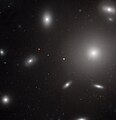Dosya:NGC 4874 HST.jpg

Vervênayışê ebadê: 578 × 600 piksel. Agoznayışê bini: 231 × 240 piksel | 463 × 480 piksel | 740 × 768 piksel | 987 × 1,024 piksel | 1,973 × 2,048 piksel | 3,864 × 4,010 piksel.
Ebato oricinale (3,864 × 4,010 pikselan, ebatê dosya: 5.95 MB, MIME tipê cı: image/jpeg)
Verêniya dosya
Seba diyayışê viyarteyê dosya ra tarixê ke qısımê tarix/zemani derê inan bıtıkne.
| Tarix/Zeman | Resımo qıckek | Ebadi | Karber | Mışewre | |
|---|---|---|---|---|---|
| nıkayên | 11:55, 20 Keşkelun 2011 |  | 3,864 - 4,010 (5.95 MB) | Jmencisom |
Gurenayışê dosya
The following pages link to this file:
Gurenayışê dosyaya gılovere
Ena dosya wikiyanê binan de gureniyena.
- ar.wikipedia.org sero guriyayış
- arz.wikipedia.org sero guriyayış
- ast.wikipedia.org sero guriyayış
- az.wikipedia.org sero guriyayış
- be.wikipedia.org sero guriyayış
- ce.wikipedia.org sero guriyayış
- cs.wikipedia.org sero guriyayış
- de.wikipedia.org sero guriyayış
- en.wikipedia.org sero guriyayış
- et.wikipedia.org sero guriyayış
- eu.wikipedia.org sero guriyayış
- fr.wikipedia.org sero guriyayış
- hr.wikipedia.org sero guriyayış
- it.wikipedia.org sero guriyayış
- ja.wikipedia.org sero guriyayış
- kk.wikipedia.org sero guriyayış
- ko.wikipedia.org sero guriyayış
- mk.wikipedia.org sero guriyayış
- nl.wikipedia.org sero guriyayış
- pl.wikipedia.org sero guriyayış
- ru.wikipedia.org sero guriyayış
- sk.wikipedia.org sero guriyayış
- sl.wikipedia.org sero guriyayış
- tt.wikipedia.org sero guriyayış
- uk.wikipedia.org sero guriyayış
- uz.wikipedia.org sero guriyayış
- www.wikidata.org sero guriyayış
- zh.wikipedia.org sero guriyayış
